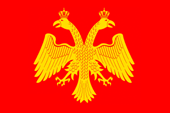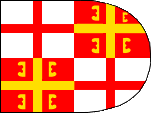mobile View, to the German Version tap the flag


- historical Empire in the Eastern Mediterran Sea
- formed in 395 after the partition of the Roman Empire
- perished in 1461 with the end of the Empire of Trebizond
- own name: Basileía Rhōmaíōn (Imperium Romanum)
- other names: East Roman Empire, East Rome, Romëic Empire, Byzantine Empire
• Flags
• Meaning/Origin of the Flag
• Map
• Numbers and Facts
• History
• Origin of the Country's Name

Flagge of Byzantium,
Source, by: Die Welt der Flaggen




13th to 15th century,
Standard of the emperor,
Source, by: Die Welt der Flaggen




The symbol of the Byzantian Empire waa a golden twin headed eagle on red ground. As flag of the empire this symbol got far spreaded since the 11th century. In the practice the flag was frequently added by further symbols, sic the heraldry of the respective house of the sovereigns or Christus monograms, or the eagle was golden circumscribed. The emperors had personal standards, which gave back the heraldry of the respective house of the sovereigns. The Paleologes (Palaiologes) combined in their standard the of cross St. George with a golden cross, which contained in his corners four fire steels. This symbol is until today used by Serbia, and has his origin probably in the heraldry of the Order of the Golden Fleece, it could even be four times the Greek letters "B" sein. => Baleologes
Source: Die Welt der Flaggen

The Byzantine Empire in the 5th century:

Source: Professor G. Droysens Allgemeiner Historischer Handatlas

Capital: Constantinople (today's Istanbul)
official Language: Greek
Source:
Atlas zur Geschichte,
Weltgeschichte

395 · partition of the Roman Empire into East Roman and West Roman Empire
399–401 · repulse of the Gotes
531–562 · war against the Persian Empire
533–534 · conquest of the Wandalic Empire
535–554 · conquest of the East Gotic Empire
568 · loss of upper Italy to the Langobardes
627 · victorious war against the Persian Empire
642–643 · Arabian invades
718 · repulse of the Arabs
1081–1185 · repulse of the Petscheneges
1204–1261 · Latin Empire of Konstantinopel, therewith shattering of Byzanz into the Empire of Nicaea, the Empire of Trebizond and the Despotate of Epirus
1261 · re-conquest of Konstantinopel
1453 · conquest of Konstantinopel by the Turks (Ottoman Empire)
1461 · conquest of Trebizond by the Turks
Source:
Atlas zur Geschichte,
Weltgeschichte

The country can be found in historiography under many names: Byzantine Empire, Byzantium, Eastern Rome, East Roman Empire, Eastern Roman Empire, Romëic Empire, Byzantine Empire. The name of the country goes back to the partition of the Roman Empire in 395 into an Eastern Roman and a Western Roman Empire. Even this country's name goes back to a locality, the city of Rome. The Western Roman Empire fell relatively quickly, in 476 with the deposition of the last Roman emperor Romulus Augustulus, and in 486 with the fall of the Empire of Syagrius as the last Roman governor. The Eastern Roman Empire still existed for many centuries and because the Roman Empire with Western Rome had almost perished, the capital of the Eastern Roman Empire – Byzantium – became the center of the Roman world, as the proverbial Second Rome. This is also to see in the self-image of the country, which called itself Basileía Rhōmaíōn (Imperium Romanum), in the local language Greek. The inhabitants did not see themselves as Greeks either, but as "Romëans", i.e. Romans. Some historians, chroniclers and contemporary witnesses also named the country after the capital, where the name Byzantine Empire comes from, even if the city was renamed in "Constantinopolis" in the year 337, after the death of Emperor Constantine. The name Constantinople was retained for the city until it was conquered by the Turks in 1453, who renamed the city in "Istānbūl", even though "Kostantiniyye" was still used during a transitional period.
Source:
Wikipedia (D),
Volker Preuss


![]()








